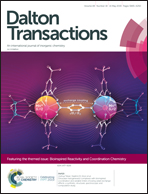Direct intramolecular carbon(sp2)–nitrogen(sp2) reductive elimination from gold(iii)†
Abstract
The reactivity of bidentate AuIII–Cl species, [(C^N)AuCl2], with a bisphosphine or carbon donor ligands results in reductive elimination. Combined experimental and computational investigations lead to the first evidence of a direct intramolecular C(sp2)–N(sp2) bond formation from a monomeric [(C^N)AuCl2] gold(III) complex. We show that bidentate ligated Au(III) systems bypass transmetallation to form C(sp2)–N(sp2) species and NHC–Au–Cl. Mechanistic investigations of the reported transformation reveal a ligand-induced reductive elimination via a key AuIII intermediate. Kinetic studies of the reaction support a second-order rate process.



 Please wait while we load your content...
Please wait while we load your content...